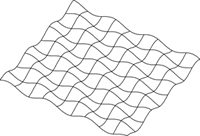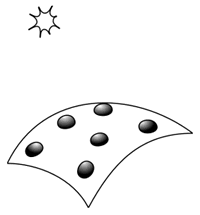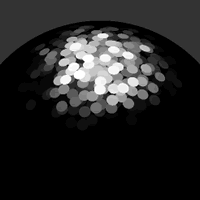Visual perception of tridimensionnal textured objects in virtual environments
The surface properties of an object are great sources of information when one try to understand its tridimensionnal structure. The repetitive and homogeneous pictural aspect of textures basic elements actually reveals the geometry of the underlying surfaces. This depth cue has been called Texture Gradient and is often used in mathematical surfaces representations, for example, as seen on figure 1.

Fig 1.Texture gradient in use: representation of a 3D surface
Roughness is another surface property that can be easily applied to virtual objects thanks to the Bump-Mapping method. We found that the interaction between the incident light and the local relief of the surface produces a pattern of shades that can be used as a cue leading to the perception of curvature (see fig. 2).

Fig. 2. The interaction between light and corrugated curved surfaces produces specific patterns of shades
Others perceptual effects, such as glitter shown on fig. 3, can be achieved using normal vectors perturbation textures.
Fig. 3. Extracted frame from an animation
This thesis is granted by Renault and the ANRT. It is meant to measure and to improve the accuracy of textured virtual objects geometry perception, using real-time image synthesis techniques. This is especially important for virtual mockup and perceived quality applications such as P2V.
References :
J.F. Blinn. Simulation of wrinkled surfaces. In Computer Graphics (SIGGRAPH ’78 Proceedings), volume 12, pages 286-292, August 1978.
J.J. Koenderink, A. J. van Doorn and A. M. L. Kappers. Pictorial surface attitude and local depth comparisons. Perception & Psychophysics, 58(2): 163-173, 1996.
M. Vallet, D. Paillé, A. Monot and A. Kemeny. Ecological model of glittering texture. Proceedings SPIE Vol. 5007, p. 310-320, Human Vision and Electronic Imaging VIII, 2003.


